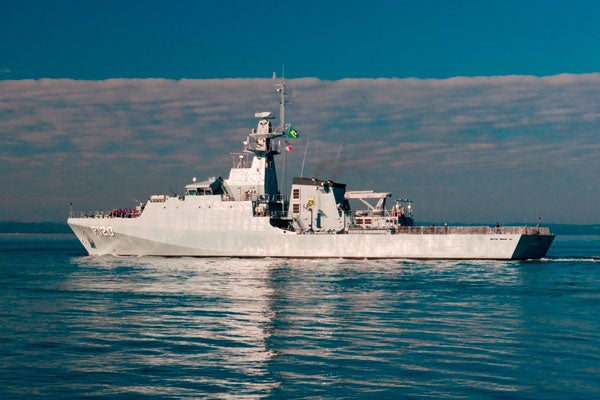
The Amazonas Class Offshore Patrol Vessels (OPVs) were introduced into the Brazilian Navy under the PROSUPER programme. Three vessels have been built and delivered by BAE Systems between 2012 and 2013.
The Brazilian Navy placed a £133m ($210m) contract with BAE Systems for the delivery of three ocean patrol vessels and associated support services in January 2013. BAE Systems also delivered the Brazilian Navy with a design information package allowing the construction of further OPVs in Brazil.
Construction and delivery details of Amazonas Class OPVs
The offshore patrol vessels were originally constructed for the Trinidad and Tobago Government under a contract ratified in 2007. The first vessel was built at a Portsmouth facility, while the remaining OPVs were constructed at BAE Systems’ Scotstoun shipyard. The ships have been offered to interested countries after the termination of the contract in late 2010.
The first vessel in the series, Port of Spain (now P120 Amazonas) was launched in November 2009, and was delivered to the Brazilian Navy in June 2012. The ship left Portsmouth in August 2012 and arrived in Brazil in October 2012.
The second ship, Scarborough (now P121 Apa) was launched in November 2009 and commissioned into the Brazilian Navy in November 2012. The third OPV in class, San Fernando (now P122 Araguari) was launched in July 2010 and delivered to the Brazilian Navy in June 2013.
Amazonas Class OPV design and features
The Amazonas Class OPVs are based on the design of the smaller 80m River Class patrol boats of the UK Royal Navy. The OPVs are designed to conduct economic exclusion zone (EEZ) patrol missions and can be deployed in maritime security, humanitarian relief and search-and-rescue (SAR) missions in territorial waters of Brazil.
The modular design of the OPVs allows for modifications to meet the individual and operational requirements of the navies across the globe. Each vessel can accommodate 70 crew members and 50 embarked troops or passengers. The ample deck space allows the carriage of six 6m ISO containers, a 16t crane, and a Pacific 24 fast interceptor craft.
The Amazonas Class OPV has a length of 90m and a maximum beam of 13.5m. The standard and full load displacements of the vessel are 1,800t and 2,200t respectively.
Amazonas Class OPV armament
The main gun mounted on the forward bow deck is a DS30M Mark 2 system mounting a 30mm Mark 44 Bushmaster II cannon. The gun is provided with Electro-Optical Director (EOD) for identification and tracking of targets.
The secondary armament includes two 25mm guns. The port and starboard sides of the vessels can be additionally mounted with 12.7mm guns.
Flight deck of Amazonas Class OPV
The aft helicopter deck of Amazonas Class OPV allows the operations of one helicopter. The 20m flight deck can accommodate a 7t medium-lift helicopter. The embarked helicopter allows extended range patrols, troop transfers, and SAR missions. The OPV lacks hangar facilities for embarked helicopters.
Amazonas class navigation and communication
The Amazonas Class OPV is equipped with an air and surface surveillance radar, X-band navigation radar, and S-band navigation radar. The vessels integrate OSIRIS combat management system from Ultra Electronics. The system integrates shipboard sensors, electro-optical systems, and weapon systems. The system provides command and control for the vessel and fire control for gun system.
The onboard communication systems include HF and VHF transceivers, and a global maritime distress safety system (GMDS).
Amazonas Class OPV propulsion
The offshore patrol vessels are powered by two MAN diesel engines driving two Warstilla propellers. Each engine develops a power of 7,350kW. The propulsion system provides a maximum speed of 25kt and a range of 5,500mi. The OPV can operate at sea continuously for 35 days.
The Global Naval Surface Combatants and Warfare Systems Market 2011-2021
This project forms part of our recent analysis and forecasts of the global naval surface combatants and warfare systems market available from our business information platform Strategic Defence Intelligence. For more information click here or contact us: EMEA: +44 20 7936 6783; Americas: +1 415 439 4914; Asia Pacific: +61 2 9947 9709 or via email.
Related content
POVZEE Offshore Patrol Vessel (OPV) Venezuela
The POVZEE (Patrullero Oceánico de Vigilancia de la Zona Económica Exclusiva) vessels were built by Spanish shipbuilder Navantia for the Venezuelan Navy.
L’Adroit Offshore Patrol Vessel, France
L’Adroit is a Gowind Class offshore patrol vessel (OPV), which was designed and built by DCNS for the maritime safety and security (MSS) missions of the French Navy.







.gif)




